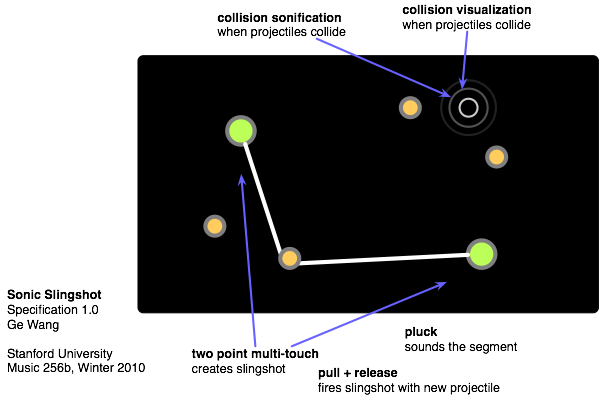256b-winter-2011/hw2
From CCRMA Wiki
Contents
Homework #2: SonicSlingShot (SSS)
Due date: 2011.1.31 11:59:59pm (or thereabout), Monday.
The goals of this assignment:
- set up a flip view (one for real-time graphics, one for UI elements)
- using the Synthesis Toolkit for iPhone
- real-time graphics via OpenGL ES
- basic physical simulation + interaction
- musical mapping
Specification (part 1 of 3): Setup: Flip View, OpenGL ES, STK
- create a project containing a flip view
- this should be covered in class, and reviewed from the tutorial.
- get graphics set up with a orthographic projection, using mo_gfx
- compile in STK, make some sounds via mo_audio
Specification (part 2 of 3): The Slingshot Interaction
The slingshot in this assignment operates as follows:
- initial state: empty screen
- two point multitouch: creates a "rubber band" (rendered as some type of line)
- third point: the rubber band maybe gently plucked (should see some wave forms, may even be the actual waveform)
- should sounds like a plucked string, pitch determined by length!
- thrid point: pulling and holding in any direction on the rubber band stretches it
- release: restores the rubber band, while shooting a projectile into the space
- the direction and velocity of the projectile should be determined by angle and how far the rubber band is stretched
Specification (part 3 of 3): Collision Detection + Mapping
- check for collision:
- against the boundaries of the screen
- against other projectiles
- collision detection should generate a visual cue somehow
- use texture mapping to create an animation
- collision detection should generate events that gets sonified (you choose the sonification)
- think about how to map the collisions to sound parameters
- add a few options to the flip view, here are some to implement and some suggestions:
- enable accelerometer and introduce gravity into the system (a toggle)
- shake to clear the space (a toggle)
- add damping to the system, i.e., projectiles loss energy and slow down over time (a slide for amount of damping)
- a mapping of your own
- (optional) reverberation / panning
Tips
- do things in chunks, unit test when possible!
- make things as simple as possible...Global variables are fine for now.
Note
- have fun with it!!!
- comment your code!
- choose your own coding conventions - but be consistent
- you are welcome to work together, but you must do/turn in your own work
Deliverables
turn in all files by putting them in your Library/Web/256b/hw2/ directory, and concise online documentation + readme + email ge + jieun + nick
- 1) source code to the project(s) (*.h, *.cpp, *.m *.mm *.c makefile, project files, etc.)
- 2) online page for your project (should be viewable at http://ccrma.stanford.edu/~YOURID/256b/hw2). It should include:
- links to your files of various kinds (or to a zip/tar archive)
- instructions on building the project (for example, anyone in the class should be able to download and run)
- a short README text section that:
- conveys your ideas/comments in constructing each program
- describes any difficulties you encountered in the process
- lists any collaborators
- 3) email Ge, Jieun, and Nick with the link to your web page, as a confirmation that you are submitting the assignment
